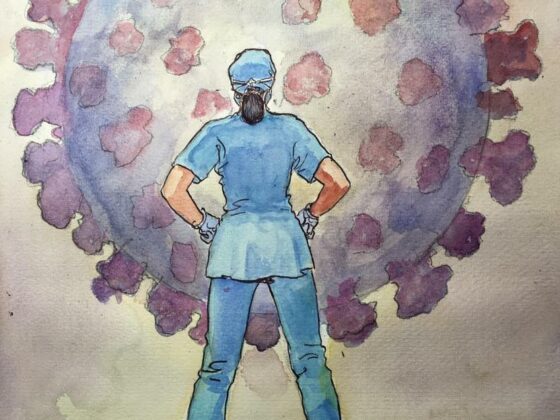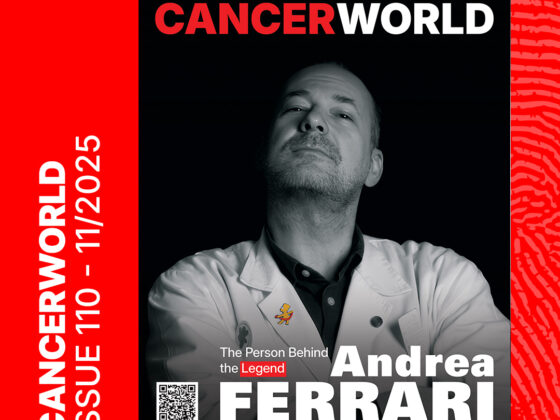Metastases, but no primary tumour – the diagnosis ‘cancer of unknown primary’ still presents great challenges, even in this age of precision oncology. Cancer of unknown primary (CUP) is an entity that encompasses a heterogenous group of metastatic cancers without an identifiable primary culprit. The elusive primary tumour puts clinicians in a rare dilemma: How do you treat metastases when you don’t know where they came from? One specialist, who has been studying the biology and clinical course of CUP, is convinced that current approaches, which try to find a likely tissue of origin and treat the tumour accordingly, are failing patients. “The current therapeutic approach is wrong. Clinicians try to assign the metastasis of a given patient to an organ, and then they treat the patient, as if the patient has a cancer from that organ. I think this is a misuse of precision medicine, because that is the wrong target”, says Paolo Comoglio, principal investigator of a large research project on this topic at the Candiolo Research Institute in Piedmont, Italy.
Currently, little is known about CUP biology and the treatment options available to patients are limited, says Natalie Cook, Senior Clinical Lecturer in Experimental Cancer Medicine at The University of Manchester and Honorary Consultant in Medical Oncology at the Christie Hospital. “Even when a diagnosis is made quickly, these patients don’t have a great prognosis. The only approved treatment option is chemotherapy, patients do not have access to molecular tests, immunotherapies or targeted agents.”
CUP: a separate disease entity?
Standard diagnosis involves a detailed history and physical examination, blood tests, expert pathological review and CT imaging of the chest, abdomen and pelvis. These diagnostic recommendations have probably led to a better identification of these ‘hidden’ primaries, as the incidence of CUP has been decreasing since the 1990s (Rassy E & Pavlidis N. Cancer Epidemiol 2019). Recent work by Nicholas Pavlidis, Emeritus Professor, University of Ioannina, Greece, and Dean of the ESO College (ESCO), shows that the proportion of patients with cancer who are diagnosed with CUP has decreased to 1-2% owing to the recent radiological and molecular advances. But not all primaries can be detected. Even at autopsy, the primary tumour remains unidentifiable in 25-50% of CUP cases. CUP remains a deadly disease: in the UK, it is the fifth leading cause of mortality in patients with cancer, and median overall survival lies between 6 and 16 months. In spite of representing 3-5% of all new cancer diagnoses, cancer of unknown primary (CUP) is the fourth most common cause of cancer-related deaths worldwide. “Ultimately, these patients still do worse because of the long time it took to arrive at a CUP diagnosis”, Cook adds. “At this point, they’ve got a highly metastatic disease.”
Traditionally, patients with CUP are divided into two prognostic subsets according to clinical and pathological criteria. “Unfortunately, patients with a good prognosis make up only around 15-20% of all CUP patients. This subset comprises a constellation of features that are suggestive of a specific tissue of origin. The rest belong to the subgroup with unfavourable prognosis”, says Pavlidis. The subgroup with a good prognosis includes mainly women with isolated axillary node metastases from adenocarcinoma (resembling breast cancer), women with papillary serous adenocarcinoma restricted to the peritoneum (resembling ovarian cancer), patients with squamous carcinoma of the cervical lymph nodes (resembling head and neck cancer), as well as men with bone metastases and elevated serum PSA (resembling prostate cancer).
“Patients with CUP categorised within the good prognostic subset are basically treated similarly to the corresponding primary tumour with systemic therapy”, explains Pavlidis. “If tumours carry specific biomarkers that identify them as a CUP subset responding to precision therapies, that is, lung, renal or colorectal cancer, patients should be managed accordingly using the relevant targeted therapy.” In patients with a good performance status, the median overall survival in the favourable subset is 15-20 months.
For the majority of patients with CUP, this option is not available. The second subset encompasses the remaining majority of patients, approximately 80-85%, who present with disseminated disease that cannot be assigned to the favourable entities. For example, liver CUP is the most common unfavourable entity (Bochtler T & Krämer A. Front Oncol 2019). It has a dismal prognosis with a median overall survival of 1-2 months. These patients are treated with empirical chemotherapy, normally doublet chemotherapy containing platinum and/or a taxane, or best supportive palliative care. Overall, the prognosis of patients in the unfavourable subgroup is just 6-12 months, a prognosis that has remained largely unchanged over the years.
Tissue-of-origin: A necessity or a distraction?
Experts differ on how best to improve therapy for CUP patients with an unfavourable prognosis. Two schools of thought dominate the discussion: one group of experts recommends a tissue of origin-oriented view, using (extensive) molecular testing to identify a likely tissue of origin and treat the CUP as if it were a metastasized tumour of this organ. The other group advocates following a tissue-agnostic approach, using molecular testing to identify actionable mutations in the metastases, irrespective of where they may have originated from, which may serve as targets for targeted therapy.
CUP is a diagnosis of exclusion: As long as no primary is found, the diagnosis holds true. In a tissue of origin-oriented view, the term CUP may be no more than an umbrella term, to designate a heterogenous group of different types of cancers, the biology of which is dictated by the location of the hidden primary. A range of methods is available to try to identify a likely tissue of origin, including gene-expression profiling, gene microarrays, microRNA and DNA methylation analysis. To verify these predictions based on molecular signatures, molecular findings have been compared with autopsy findings. However, both the spectrum of likely primaries and their relative proportions differ between molecular and autopsy findings, suggesting that molecular predictions are not entirely reliable (Bochtler T & Krämer A. Front Oncol 2019; Conway A-M et al. Br J Cancer 2018; Hainsworth JD & Greco FA ASCO 2018).
So far, the evidence supporting a tissue of origin-oriented view is limited, says Alwin Krämer, Director of the Clinical Cooperation Unit Molecular Haematology/Oncology at the German Cancer Research Center. “Two recent studies have shown that identifying the likely primary does not help, at least with regard to chemotherapy,” The studies in question were two recent prospective randomised trials (Hayashi H et al. J Clin Oncol 2019; Fizazi K et al. Ann Oncol 2019) neither of which generated promising evidence for tissue-specific chemotherapy. Both trials included previously untreated patients that belong to the unfavourable CUP subgroup. The trials compared the survival of patients receiving site-specific therapy (directed by comprehensive molecular gene-expression analysis or by microarray analysis) with the survival of patients receiving empirical chemotherapy. In both studies, site-specific therapy did not improve clinical outcome in terms of overall survival, progression-free survival or one-year survival rate. On the other hand, a retrospective study (Moran S et al. Lancet Oncol 2016) found that overall survival is longer for patients who received site-specific treatment in line with a predicted tissue of origin than for patients who received empirical therapy not in line with the predicted tissue of origin.
Nevertheless, narrowing down where the metastases might originate from may still be important with regards to targeted therapy, Krämer adds. “Right now, there is no evidence that it is helpful to know the likely tissue of origin when you treat unfavourable subtype CUP with targeted therapy. Regarding targeted therapy, if this is different it is currently unknown.” And Cook points towards the different responses to BRAF inhibitors, depending on a tumour’s tissue of origin, as a hint that origin is relevant. “For some mutations, context is important. Not for all, but for some, and ultimately to understand this, we still need to be able to molecularly profile all these cancers. And looking at immunotherapies, we also know that immunotherapies work in some cancers but not in others. We can’t just understand the molecular features, we still need to know or have an idea of where this has come from.”
“We can’t just understand the molecular features, we still need to know or have an idea of where this has come from.”
The other school of thought is to move beyond the tissue of origin once a diagnosis of bona fide CUP is made, and instead focus on the mutations found in the clearly present metastases. Until now, there have only been case reports of patients with CUP responding to targeted therapy. One trial testing this approach is the CUPISCO trial, an international phase II randomized study that looks to recruit 790 patients with CUP. Krämer, who leads this Roche-sponsored trial at the University Hospital in Heidelberg, explains the rationale. “The study asks whether molecularly targeted or immunotherapy is better than standard unspecific platinum-based chemotherapy in newly diagnosed unfavourable CUP, independent of the primary site.”
After stringent patient selection, which will include only patients for whom no likely primary is found by histology or clinical features, the treatment-naive patients first receive three cycles of platinum-based chemotherapy. After induction chemotherapy, the responders are randomized to receive either platinum-based chemotherapy or molecularly-guided therapy, depending on the results of panel sequencing. Patients who did not respond to platinum-based chemotherapy all receive molecularly-guided therapy. “In a translational side project, we do methylation and gene-expression profiling to identify the primary. Then, in a post-hoc analysis, we look whether patients’ response to the targeted therapy does depend on the likely primary – or not”, Krämer adds.
At the moment, Krämer is not convinced that the tumour’s response to targeted therapy is necessarily organ specific. “It is oversimplified to look at a single mutation, such as BRAF, and believe that each and every cancer would respond in the very same way to a BRAF inhibitor. Instead, one should look at the complete genomic or mutational profile, and then decide how to treat the patient.” Krämer is also involved in a smaller trial called CheCUP, based in Germany, which investigates whether pre-treated patients with CUP benefit from combined checkpoint inhibitor treatment, and whether mutational burden predicts response. “There are significant case reports, including from our department, in which patients have significantly benefited from immunotherapy. So now we are testing whether patients benefit from a therapy with combined nivolumab and ipilimumab”, Krämer says.
The tumour-agnostic view is taken even further in another phase II trial, aptly called the AGNOSTOS programme, which is run from the Candiolo Cancer Institute, where Paolo Comoglio works. “We are looking at the mutations in CUP to see whether mutations exist that are markers of this disease, and whether they can then be targeted therapeutically. In our view, CUP is a still unrecognized pathological entity. We think it can be classified as a stand-alone disease, where the doctors do not find the primary tumour because there is no primary tumour mass. Currently, we haven’t found the one or two mutations that are markers of the disease, but hopefully there is one. And we have some candidates. We just reported the complete expression and genetic analysis of multiple synchronous metastases from a patient with CUP. The expression profiles were remarkably similar and astonishingly singular”.
Is CUP a new clinical entity?
Pavlidis agrees that CUP is likely to be a novel nosological entity. “It is a more aggressive tumour that is chemoresistent and is associated with a poor prognosis. But we have not yet identified a genetic signature or molecular explanation for it. The clinical picture of CUPs makes it likely that they represent a separate entity.” Krämer agrees. “Especially if we are looking at the ‘hardcore’ cancers of unknown primary, where a primary really escapes identification. Those, at least to my belief, represent a separate entity.”
Comoglio is hunting for the elusive, if existent, CUP-specific signature. He suspects that a common feature is the invasive growth programme. The reason for this has to do with how Comoglio thinks CUP arises and develops. So far, the mechanism explaining why the primary is unidentifiable in patients with CUP is poorly understood. One theory is that the primary tumour is successfully attacked by the immune system, while the metastases evade detection. Another theory suggests that metastases arise very early during the malignant process, or that CUP follows a type two progression without even forming a primary site. Based on an analysis of how metastases are connected phylogenetically in a CUP patient, as well as unpublished work on xenopatients, Comoglio suggests that there is no primary tumour in CUP. “Instead of a primary tumour, there is a primary cancer stem cell. This stem cell forms a small initial cluster and simultaneously acquires the transformative phenotype and the metastatic, invasive phenotype and so can’t be detected in its original site, as it immediately disperses. We think that CUP is a disease that originates from undifferentiated stem cells that mutate and acquire the invasive metastatic phenotype very early.”
“We think that CUP is a disease that originates from undifferentiated stem cells that mutate and acquire the invasive metastatic phenotype very early”
In previous work, Comoglio has studied the invasive growth programme, and the oncogenes involved in it. This is now the focus in the AGNOSTOS programme, which includes a diagnostic profiling arm and a clinical trial. “The invasive growth programme drives cells to divide, but also to migrate. For this reason, we are focusing on the genes of the invasive growth programme, including MET kinase.”
The results of clinical trials in CUP will not only benefit CUP patients with poor prognosis. Instead, findings, especially from the CUPISCO trial, will be relevant also for the treatment of other metastatic cancers, says Krämer. “Cancer of unknown primary is a disease that, until recently, only few people were interested in. A trial like CUPISCO would not have been possible in CUP if industry had not become interested in looking at tumour-agnostic treatment options.” CUP is a testbed to trial tumour-agnostic therapy. “CUP is a poster-child of metastatic disease to understand whether knowing the primary is necessary for delivering a successful targeted therapy. It is much harder to test whether treating metastatic disease from known primaries in a tumour-agnostic way is possible, because this would require a randomized, first-line trial. This would be a far more complicated trial, because for most of these diseases there is a successful standard of care. Which is different from cancer of unknown primary, where there is a standard of care, but it is not successful.” Cook agrees that new trials are important. “There is limited evidence for a targeted approach in CUP currently. However when you see how many targeted therapies, and immunotherapies, there are being approved in other cancer types, we need to build the evidence to look for these new treatment approaches in CUP.”
“CUP is a testbed to trial tumour-agnostic therapy”
Illustration by: Maddalena Carrai












